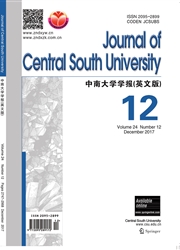

 中文摘要:
中文摘要:
为了在液化地点,一个可溶解的地点和一个非可溶解的地点理解地震反应的特征,被选择,由大约 500 m 分开了并且在国家地震作为班 D 有一样的地点条件冒险减小节目(NEHRP ) 。岩石地点上的地震记录的一间套房为大小被选择并且可伸缩到 Joyner, Boore,和 Fumal (JBF ) 变细模型的光谱在 50 km 的距离的 7.5 地震。放大记录然后被用来使二个地点激动。毛孔水压力的效果用有效压力分析方法被调查,并且非线性的土壤行为被围住表面模型的土壤建模。为系列,山峰地面加速(针网阵列) ,山峰地面排水量(PGD ) 和永久排水量的比较被执行。结果证明在非液化的地点的吝啬的地面反应光谱从 JBF 模型接近估计的地面反应光谱,但是平均数在液化地点扎根反应光谱是比从为多达 1.3 s 的时期的 JBF 模型的估计的地面反应光谱低得多的。在非液化的地点的吝啬的针网阵列在液化地点 1.61.7 倍大于那在附近,但是在非液化的地点的吝啬的山峰地面排水量(PGD ) 在液化地点与那有细微差别。在液化地点的吝啬的永久排水量比在非液化的地点的那些大,特别地在液化的层。
 英文摘要:
英文摘要:
To understand the characteristics of seismic response at liquefied sites, a liquefiable site and a non-liquefiable site were selected, separated by about 500 m and having the same site conditions as Class D in the National Earthquake Hazards Reduction Program (NEHRP). A suite of earthquake records on rock sites are selected and scaled to the spectrum of the Joyner, Boore, and Fumal (JBF) attenuation model for a magnitude 7.5 earthquake at a distance of 50 km. The scaled records were then used to excite the two sites. The effect of pore-water pressure was investigated using the effective stress analysis method, and nonlinear soil behavior was modeled by a soil bounding surface model. Comparisons for spectra, peak ground acceleration (PGA), peak ground displacement (PGD) and permanent displacement were performed. Results show that the mean ground response spectrum at the non-liquefied site is close to the estimated ground response spectrum from the JBF model, but the mean ground response spectrum at the liquefied site is much lower than the estimated ground response spectrum from the JBF model for periods of up to 1.3 s. The mean PGA at the non-liquefied site is about 1.6-1.7 times as large as that at the liquefied site, but the mean peak ground displacement (PGD) at the non-liquefied site has a slight difference with that at the liquefied site. The mean permanent displacements at the liquefied site are larger than those at the non-liquefied site, particularly at the liquefied layer.
 同期刊论文项目
同期刊论文项目
 同项目期刊论文
同项目期刊论文
 Analysis on mechanism of landslides under ground shaking: a typical landslide in the Wenchuan earthq
Analysis on mechanism of landslides under ground shaking: a typical landslide in the Wenchuan earthq Dynamic process analysis for the initiation and movement of the Donghekou landslide-debris flow trig
Dynamic process analysis for the initiation and movement of the Donghekou landslide-debris flow trig Finite fault modeling for the Wenchuan earthquake using hybrid slip model with truncated normal dist
Finite fault modeling for the Wenchuan earthquake using hybrid slip model with truncated normal dist Case history of the disastrous debris flows of Tianmo Watershed in Bomi County, Tibet, China: Some m
Case history of the disastrous debris flows of Tianmo Watershed in Bomi County, Tibet, China: Some m Hazards on dujiangyan-wenchuan highways induced by catastrophic debris flows on July 10 2013 and pre
Hazards on dujiangyan-wenchuan highways induced by catastrophic debris flows on July 10 2013 and pre Stochastic simulation of ground motions of the Wenchuan earthquake using slip-based corner frequency
Stochastic simulation of ground motions of the Wenchuan earthquake using slip-based corner frequency Development of strut-and-Tie model and design guidelines for improved joint in decked bulb-Tee bridg
Development of strut-and-Tie model and design guidelines for improved joint in decked bulb-Tee bridg Analysis of Dynamic Responses of Bridge-approach embankment transition section of high-speed Railway
Analysis of Dynamic Responses of Bridge-approach embankment transition section of high-speed Railway 期刊信息
期刊信息
